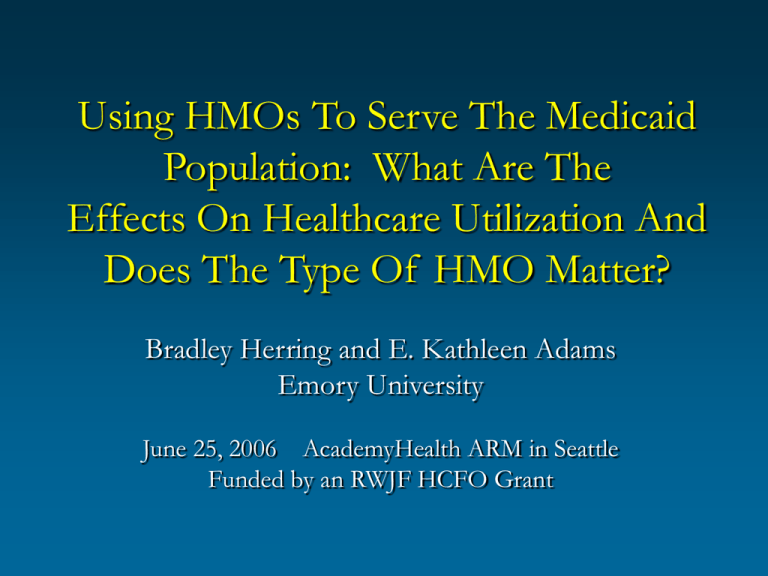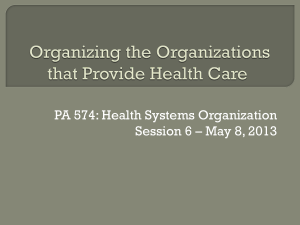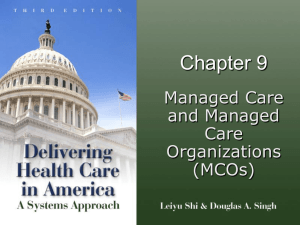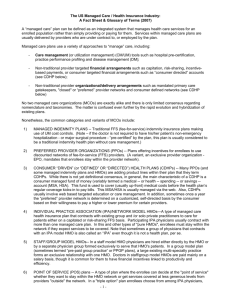Using HMOs To Serve The Medicaid Population: What Are The
advertisement

Using HMOs To Serve The Medicaid Population: What Are The Effects On Healthcare Utilization And Does The Type Of HMO Matter? Bradley Herring and E. Kathleen Adams Emory University June 25, 2006 AcademyHealth ARM in Seattle Funded by an RWJF HCFO Grant Primary Research Questions • What are the effects of using HMOs for the Medicaid population? – Does enrollee access to care change? – Do utilization patterns change? – Do overall healthcare expenses change? • Are there different effects for commercial HMOs versus Medicaid-dominant HMOs? Background • Enrollees in some form of Medicaid managed care increased from 32.1% in 1995 to 60.7% in 2004 – Primary care case management – At risk health plans: “carve out” plans and HMOs • Enrollees in Medicaid HMOs increased from 14.1% in 1995 to 39.5% in 2004 • Little consistent or generalizable empirical evidence for access to care, utilization, or total expenses State Motivation for Using Managed Care • Improve access to care, at current expense: – Improve access to “mainstream” office-based providers? – Improve quality? • Reduce expense, while maintaining access: – – – – Improve use of cost-effective preventive services? Decrease unnecessary use of the ER? Better manage chronic conditions? Use bargaining power to achieve provider discounts? • Or perhaps yield predictable budgets? Might the Type of HMO Matter? • Commercial HMOs enrolling both Medicaid and privately insured populations: – Reduce “stigma” by integrating populations? – More likely to include “mainstream” providers? – Economies of scale? • Medicaid-dominant HMOs – more than 75% of enrollees in Medicaid: – Serve unique needs (economies of scope)? – More likely to include traditional “safety net” providers? – Inefficient due to “learning by doing”? Prior Research • Early research summarized in Hurley et al. (1993) and Rowland et al. (1995) • More recent research: – State-specific analysis: CA, FL, OH, MN, TN, WI – Nationally-representative survey data: • State-level penetration or presence of MMC in a county – We compliment Duggan’s (2004) work on total state expenditures (i.e., capitation rates) by focusing on underlying utilization-based expenses Our Empirical Approach • Community Tracking Study in 60 U.S. markets – Household Survey for ‘96-‘97, ‘98-‘99, ‘00-‘01, and ‘03 – We limit to the 51 urban MSAs • MSA measures of Medicaid HMO penetration using CMS and InterStudy data for ‘96, ‘98, ‘00, and ‘02 – CMS lists all Medicaid HMOs and the counties served – We link to InterStudy data to determine whether each HMO is commercial or Medicaid-dominant – Penetration rate: the percentage of all Medicaid enrollees in that HMO type Medicaid HMO Penetration Rates of Urban CTS Markets by Period Variables: HMO (both types) penetration rate Commercial HMO penetration rate Medicaid-dominant HMO penetration rate 1996 1998 2000 2002 24.7% 35.9% 32.4% 42.1% 8.5% 14.3% 12.4% 12.1% 16.2% 21.6% 20.0% 30.0% Source: Complied CMS and InterStudy data Our Empirical Approach (cont.) OUTCOMEit = f (ßHMO XHMO,it + ßI XI,it + ßAREA XAREA,it + γMSA MSAi + γYEAR YEARt, ε) where OUTCOMEit = a specific outcome measure for Medicaid enrollee i during time t XHMO,it = measures of commercial and Medicaid-dominant HMO penetration XI,it = a set of individual characteristics XAREA,it = a set of local area characteristics MSAi = a set of MSA indicator variables YEARt = a set of year indicator variables ε = an error term Medicaid Enrollees in the CTS-HS: Three Sets of Dependent Variables • Sample: 9134 non-elderly with Medicaid in the CTS-HS – Includes children in SCHIP – Adults and children both together and separate • 1st set: Access measures: – – – – Usual source of care other than the ER Usual source of care is the ER Having a difficulty in obtaining care Being satisfied with one’s primary care doctor Medicaid Enrollees in the CTS-HS: Three Sets of Dependent Variables (cont.) • 2nd set: utilization measures: – – – – Office-based physician visits Any mental health services Inpatient stays Inpatient surgeries – – – – Medical practitioner visits ER visits Inpatient nights Outpatient surgeries • 3rd set: “synthetic” estimate of total healthcare expenses using CTS-HS utilization & the MEPS: – 1996-2003 MEPS to regress actual expense on utilization – The MEPS coefficients are essentially “unit prices” Medicaid Enrollees: Independent Variables • Variables of interest: – Commercial HMO penetration rate – Medicaid-dominant HMO penetration rate • Individual controls: – Age and gender, family type (e.g., single with kids), family income, race/ethnicity, education, self-reported health status • Local-area controls: – PCCM, type of SCHIP expansion, Medicaid fee index, MDs/capita seeing Medicaid, hospital beds/capita, FQHC, private HMO penetration, median income, race/ethnicity • MSA fixed effects and time trend Results for Commercial HMOs • Child enrollees: – No effect on access – No effect on utilization – No effect on expenses • Adult enrollees: – No effect on access – Increase only for mental health visits (p<0.05) – Decrease in expenses (p<0.10) Results for Medicaid-Dominant HMOs • Child enrollees: – Decrease in usual source of care other than ER (p<0.10) – Increase in medical practitioner visits (p<0.10) Increase in ER visits (p<0.05) – Increase in healthcare expenses (p<0.05) • Adult enrollees: – Increase in using the ER as a usual source of care (p<0.10) – Increase in medical practitioner visits (p<0.05) Decrease in inpatient surgeries (p<0.001) Decrease in outpatient surgeries (p<0.05) – No effect on healthcare expenses Magnitude of the Effect of Medicaid-Dominant HMOs • We simulate the independent effect of the increase in the Medicaid-dominant penetration rate of 16.2% in 1996-1997 to 30.0% in 2002-2003: – Proportion reporting a (non-ER) usual source of care: Reduced from 86.2% to 84.8% – Number of visits to the ER: Increased from 0.654 per year to 0.732 per year – Total healthcare expenses (in 2003$): Increased from $3004 to $3163 (a 5.3% real increase) Conclusions • Increase in penetration by commercial HMOs: – – – – No change in access to care Little change in utilization patterns No increase in expenses (perhaps a decrease for adults) (Our other work: increase in physician participation) • Increase in penetration by Medicaid-dominant HMOs: – – – – Worse access to care Many changes in utilization Increase in expenses for children; No change for adults (Our other work: no change in physician participation) Policy Implications • What’s the real motivation for contracting with HMOs? – Welfare improvements from either improved access and maintained expense -or- lower expense and maintained access • Our results suggest that – States may have seen small welfare improvements by contracting with commercial HMOs before their exit – States have seen (and will see) decreases in welfare by contracting with Medicaid-dominant HMOs • Attention needed in setting capitation rates and fees – Exits by commercials & pressure from Medicaid-dominants







